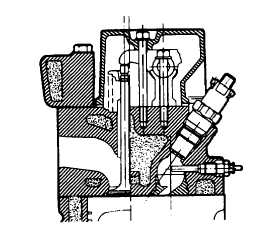| |
TM 10-3930-671-24
The function of the cooling system is to prevent the
temperatures in the combustion chamber from damaging
the engine and at the same time keep the operating
temperatures within safe limits.
Maintaining the cooling system efficiency is important, as
engine temperatures must be brought up to and
maintained
within
satisfactory
range
for
efficient
operation; however, this system must be kept from
overheating in order to prevent damage to valves,
pistons, and bearings.
Never pour cold water or cold anti-
freeze into the radiator of an over-
heated engine. Allow the engine to
cool and avoid the danger of cracking
the cylinder head or block. Keep
engine running while adding coolant.
COOLING SYSTEM
All Continental industrial diesel engines have the coolant
force-circulated by a water pump and use a thermostat
and by-pass system to control the temperature range.
The coolant from the pump enters the front of the block,
passing along and between the cylinder bores and is
metered by the head gasket into and across the cylinder
head to cool the pre-combustion chambers, valve seats,
and guides.
Upon leaving the cylinder head, the coolant enters the
thermostat housing, in which is mounted the positive
shut-off thermostat that controls the opening to the
radiator or heat exchanger. Upon being discharged from
the thermostat housing, the coolant enters the radiator or
heat exchanger, depending upon the application, where
it is cooled before reentry into the engine. Continental
industrial diesel engines operate most efficiently with
coolant temperatures of 1800 - 200°F (810 93°C) and a
thermostat and bypass system is used to control these
temperatures.
The thermostat valve remains closed and only allows the
coolant to circulate within the engine itself until normal
operating temperatures are reached. This provides for
both rapid and even temperature increase of all engine
parts during the warm-up period. When desired
temperature is reached, the thermostat valve opens
allowing all the coolant to circulate through both the
engine and radiator while shutting-off the bypass system.
IMPORTANT
Present thermostats begin to open at
81°C (180"F) and are fully open at
940C (202°F). Operation of engines in
this temperature range is not harmful.
However, temperature gauges are not
always accurate and may sometimes
Indicate
higher
than
actual
temperature. This can lead operators
to believe engines are overheating
when they are actually operating
normally.
Sectional View showing Coolant Passages in Head &
Block
EXPANSION OF WATER
Water has always been the most commonly used
coolant for internal combustion engines because it has
excellent heat transfer ability and is readily obtained
everywhere. Like all liquids, it expands when heated (the
rate of expansion being 1/4 pint per gallon (1/32 liter per
liter) when the temperature is raised from 40° to 180°F
(40 to 81°C).
For example: If a 4 gallon cooling system is filled
completely full of water at 40°F (4°C), 1 pint will be lost
through the radiator overflow pipe by the time the water
temperature reaches 180°F (81°C).
WATER FILTERS
In some areas, the chemical content of the water is such
that even the best of rust inhibitors will not protect the
cooling system from the formation of rust and scale.
F-145
Section 4- Cooling System
|

